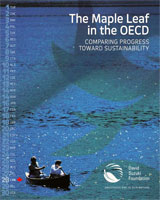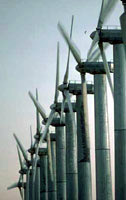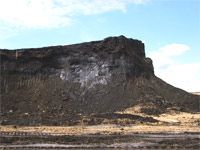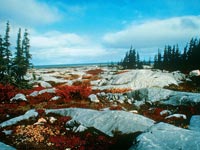
News |
- Manitoba Wildlands New Look & Logo
- Fisher Bay and Birch Island Park Reserves Extended
- SCO's Water for Life Conference in Winnipeg
- Manitoba Forestry Conflicts
- Canada's Environmental Performance Ranked
- Wind Energy in Canada to Take Off
- Film Profiles Manitoba Hydro Communities
- Manitoba Lags Behind on Climate Change
- Call for New Polar Bear Protection
- Protecting Heritage an Investment
- Fossil Fuels from Oil Sands - At What Cost?
- New Arctic Development Thanks to Climate Change
| Manitoba Wildlands New Look & Logo | 07 November 05 |
 Manitoba Wildlands is pleased to introduce a fresh new look for ManitobaWildlands.org. The new look includes our new, locally designed, owl logo. Manitoba Wildlands is pleased to introduce a fresh new look for ManitobaWildlands.org. The new look includes our new, locally designed, owl logo.We did a whole lot of brainstorming and we kicked around many ideas; we knew we wanted a visual identity that resonated with Manitobans and reflected an important provincial species. We also wanted to connect to our work in support of protecting Manitoba's lands and waters. Owls are important in Manitoba and in the boreal forest. The Great Gray Owl is Manitoba's provincial bird and North America's largest owl, with a wingspan of 1.3 metres. It is also a year-round resident of Manitoba's boreal forests. The image of a 'wise old owl' was something we want to evoke. Our work is about doing our best to be wise when it comes to the environment; saying what needs to be said and doing what needs to be done on behalf of the land, waters, and the wildlife. We enlisted a young Manitoba designer to help move our brainstorming into an image. We looked at many owls before finally settling on one! Then our talented webmaster set to work to redesign the web site around the Manitoba Wildlands owl - not a small task! We would love to hear comments on our fresh and new look. Please let us know what you think - send any comments to webmaster@manitobawildlands.org |
|
| Fisher Bay and Birch Island Park Reserves Extended | 07 November 05 |
 Conservation Minister Stan Struthers announced November 1, 2005 that Fisher Bay and Birch Island - two northern Interlake park reserves - will continue to be protected for another five years. Conservation Minister Stan Struthers announced November 1, 2005 that Fisher Bay and Birch Island - two northern Interlake park reserves - will continue to be protected for another five years.The Fisher Bay and Birch Island Park Reserve together constitute about 168,000 hectares and were initially established in May 2000. Both were nominated by the First Nation community. Currently, 13 park reserves - areas nominated by First Nations and designated under the Parks Act - are protected from development (logging, mining and hydroelectric development). View the November 1, 2005 Manitoba Government press release regarding the Park Reserves View the November 1, 2005 Parks Act Regulation (161/2005) (PDF) View Manitoba Wildlands' map of Fisher Bay and Birch Island Park Reserves View the October 13, 2005 Manitoba Wildlands news item on Fisher Bay and Birch Island Park Reserves Source: Government of Manitoba |
|
| SCO's Water for Life Conference in Winnipeg | 02 November 05 |
 The SCO hosted a two-day conference on October 19th & 20th looking at ways of protecting the province's water resources. Indigenous water rights, the impact of hydro-electric dams and the state of the fishery were among the topics at the Water for Life conference. The event was affiliated with the United Nations International Water for Life Decade of Action. The SCO hosted a two-day conference on October 19th & 20th looking at ways of protecting the province's water resources. Indigenous water rights, the impact of hydro-electric dams and the state of the fishery were among the topics at the Water for Life conference. The event was affiliated with the United Nations International Water for Life Decade of Action.World-renowned environmentalist David Suzuki was a featured speaker the first day of the conference. He commented on the Doer government's plans to resurrect the Conawapa project, a 1,250-megawatt dam on the Nelson River that would be the second largest generating station in the province. "We need to use alternative energy sources and get off this kick that we've got to have these great big projects that governments love so much," Suzuki said. Instead, Suzuki said a government should look to a mix of sources that would incorporate micro-hydro dams with wind, solar and geothermal energy. Manitoba Wildlands director Gaile Whelan Enns was a presenter at the conference on the second afternoon, see presentation below. View the Water for Life conference poster View the October 20, 2005 Winnipeg Free Press article on the Water for Life Conference (DOC) View the Manitoba Wildlands presentation to the Water for Life conference, Citizens in Water Initiatives (PDF) Sources: Southern Chiefs Organization, Winnipeg Free Press |
|
| Manitoba Forestry Conflicts | 02 November 05 |
 Two of the major forestry companies in Manitoba - Tembec and Tolko - have been the subject of recent controversy. Two of the major forestry companies in Manitoba - Tembec and Tolko - have been the subject of recent controversy.Tembec, who holds a forest management license on the province's east side, was taken to court by Ron Alexander, who operates Bird River Outfitters. Mr. Alexander claimed Tembec violated sections of the Crown Lands Act and the Manitoba Forest Act when it cut down too many trees at sites near Shoe Lake in 2003 and 2004. Manitoba Justice took over the prosecution and then stayed the charges. Manitoba crown attorney Sean Brennan told a provincial court judge that prosecuting the company was not in the public's interest. Brennan said Manitoba Conservation has already enacted several measures against the company including having it report on a weekly basis regarding cutting plans. In The Pas, residents launched a petition campaign to stop Tolko from logging in Rocky Lake - a favorite recreation area for both locals and tourists located about 50 km north of the community. The company has proposed an expansion of the standard 100-metre buffer around the lake and other changes to accommodate all-terrain vehicle and snowmobile trails. View the September 20, 2005 Winnipeg Free Press article on the suit against Tembec View the October 2, 2005 Winnipeg Free Press article on the opposition to Tolko logging plans Source: Winnipeg Free Press |
|
| Canada's Environmental Performance Ranked | 27 October 05 |
 Canada is one of the worst environmental performers in the industrialized world, according to a comprehensive new report released October 18, 2005 by the David Suzuki Foundation. Canada is one of the worst environmental performers in the industrialized world, according to a comprehensive new report released October 18, 2005 by the David Suzuki Foundation.Canada ranks 28th out of the 30 member countries of the Organization for Economic Co-operation and Development based on 29 key environmental indicators. These include: energy consumption, water consumption, greenhouse gas emissions, air pollutants, pesticide use, and amount of land in protected areas. The study, The Maple Leaf in the OECD: Comparing progress toward sustainability, found Canada has shown no improvement over the last decade. Canada's rank today is the same as it was in 1992: 28th out of 30. Canada's greenhouse gas emissions are two times higher, and major smog-causing air pollutants are two-to-three times higher than the average for other industrialized countries. "It is obvious that Canada will not improve its performance unless we enact specific legislation that lays out clear targets and timelines," says Dr. Suzuki. "We are encouraged by stated commitments to sustainability by Prime Minister Martin and Environment Minister Dion, but statements must be followed up with action. We are hopeful the prime minister will take our advice and pass a National Sustainability Act." View the full October 18, 2005 David Suzuki Foundation press release View The Maple Leaf in the OECD: Comparing progress toward sustainability (PDF) View the Executive Summary (PDF) View the graphs with data from The Maple Leaf in the OECD: Canada's Ranking in Key Measurements (PDF) View the Environmental Ranking of High-Income OECD Countries (PDF) Source: David Suzuki Foundation |
|
| Wind Energy in Canada to Take Off | 27 October 05 |
 The year 2005 was a banner year for Canada's wind energy industry, but according to the Canadian Wind Energy Association (CanWEA), the best is yet to come. By 2013, Canada's installed capacity of wind energy will have increased tenfold to 7,000 MW - enough to power over 1.8 million homes - and a significant acceleration over the 30% annual growth rates witnessed in the last five years. The year 2005 was a banner year for Canada's wind energy industry, but according to the Canadian Wind Energy Association (CanWEA), the best is yet to come. By 2013, Canada's installed capacity of wind energy will have increased tenfold to 7,000 MW - enough to power over 1.8 million homes - and a significant acceleration over the 30% annual growth rates witnessed in the last five years.Not only is Canada's wind energy industry gaining momentum, it has also caught the imagination of a vast majority of Canadians. Research conducted for CanWEA by Ipsos-Reid in February, 2005 indicated that 92 per cent of Canadians believe wind energy will play a significant role in meeting Canada's future energy needs, 96 per cent support the continued development of wind energy in Canada, and Canadians prefer the deployment of wind energy over conventional sources of electricity like coal, nuclear, hydro and natural gas. View the full October 17, 2005 Canadian Wind Energy Association (CanWEA) press release Visit the CanWEA web site Source: Canadian Wind Energy Association |
|
| Film Profiles Manitoba Hydro Communities | 25 October 05 |
 Green green water is a documentary film about hydroelectric power and its impact on the lives of thousands of Aboriginal people in northern Manitoba. Green green water is a documentary film about hydroelectric power and its impact on the lives of thousands of Aboriginal people in northern Manitoba.Filmmaker Dawn Mikkelson, collaborating with Métis-Ojibway filmmaker, James M. Fortier, travels to Manitoba to tell the story of several Cree communities whose lives have been forever altered by hydroelectric dams. In the beginning, Mikkelson hoped that by drawing attention to this situation, the Cree would receive more equitable financial compensation for their pain, but is money enough to remedy the destruction of a culture, a way of life, and a community's dignity? "This is a story about power... power from hydroelectric dams... the power to destroy an ancient culture... the power of big money... the power of Indigenous people who refuse to be powerless in their struggle to survive... and the power of activism." Visit the green green water documentary film site View the green green water Video Log (Vlog) View the 12-minute trailer for green green water Source: Aquaries Media Corporation - green green water |
|
| Manitoba Lags Behind on Climate Change | 25 October 05 |
 Most Canadian provinces are doing little or nothing to address climate change, says a new David Suzuki Foundation analysis of climate change plans. Most Canadian provinces are doing little or nothing to address climate change, says a new David Suzuki Foundation analysis of climate change plans.The Suzuki Foundation's report, All Over the Map - A Comparison of Provincial Climate Change Plans, looks at provincial and territorial actions, compares their greenhouse gas emissions, assesses climate change plans and evaluates actions. Although Canada's federal government signed the Kyoto Protocol, Canada's provinces are responsible for delivering many climate change programs. The report praises Manitoba's climate change plan as the best of all the provincial and territorial plans. The report also notes that almost half of Manitoba's emission reductions are premised on hydro power export to US and points out that "Manitoba's greenhouse gas emissions increased 11.5% between 1990 and 2003". The report is also critical of a major weakness of Manitoba's climate change plan: dependence on other governments to achieve its targets. Gaile Whelan Enns, Manitoba Wildlands Director commented that "We would like the Manitoba government to act on the recommendations of its Climate Change Task Force, especially as these relate to our Boreal forest regions." View the October 3, 2005 David Suzuki Foundation press release View the full David Suzuki Foundation report All Over the Map - A Comparison of Provincial Climate Change Plans (PDF) View Manitoba's Climate Change Plan (PDF) Visit the Manitoba Climate Change Task Force website Source: David Suzuki Foundation |
|
| Call for New Polar Bear Protection | 19 October 05 |
 Survival of the world's remaining polar bears is increasingly jeopardized by rapid disappearance of the arctic sea ice on which they depend for hunting, mating and migration. The Center for Biological Diversity, Natural Resources Defense Council (NRDC), and Greenpeace announced they are taking legal action to have polar bears listed as "threatened" under America's Endangered Species Act. Survival of the world's remaining polar bears is increasingly jeopardized by rapid disappearance of the arctic sea ice on which they depend for hunting, mating and migration. The Center for Biological Diversity, Natural Resources Defense Council (NRDC), and Greenpeace announced they are taking legal action to have polar bears listed as "threatened" under America's Endangered Species Act.The groups point to extensive scientific evidence showing that the unprecedented polar meltdown is the result of global warming. Polar bears would be the first mammal to be officially declared at risk due to global warming. The groups petitioned to have the polar bear listed as threatened February 2005. The US Endangered Species Act requires that the Secretary of the Interior respond within 90 days, but the Secretary has yet to comply. The October 12, 2005 announcement is a legally-required notice of intent to sue the agency for action. Formal filing will occur after the agency has had 60 days from the October 12th notice to comply with the law. View the full October 12, 2005 press release by the NRDC, Greenpeace USA, & the Center for Biological Diversity Visit the NRDC web site Visit the Greenpeace USA web site Visit the Center for Biological Diversity web site Source: Natural Resources Defense Council |
|
| Protecting Heritage an Investment | 19 October 05 |
 The Canadian provinces of Manitoba, Ontario, and five First Nations, are working towards establishment of a boreal cross border 4 million ha World Heritage Site. Elizabeth May, executive director of Sierra Club Canada, recently wrote the Winnipeg Free Press to support this boreal vision. The Canadian provinces of Manitoba, Ontario, and five First Nations, are working towards establishment of a boreal cross border 4 million ha World Heritage Site. Elizabeth May, executive director of Sierra Club Canada, recently wrote the Winnipeg Free Press to support this boreal vision. Elizabeth May's feature is in contrast to the newspaper's series of articles during 2005, all supporting development of the east side. Her opinion piece supports the Manitoba government's decision to keep transmission corridors out of this boreal region. To read E. May's piece see below. View the full Sierra Club of Canada opinion piece (DOC) View the September 29th, 2005 Winnipeg Free Press Editorial(DOC) View the World Heritage Site Nomination Map Visit the Poplar River First Nation website Source: Sierra Club of Canada |
|
| Fossil Fuels from Oil Sands - At What Cost? | 17 October 05 |
 The public is starting to pay attention to the environmental costs of extracting oil from Canada's oil sands in Northern Alberta - as oil companies rush to develop them in the face of rising prices for a barrel of oil. The public is starting to pay attention to the environmental costs of extracting oil from Canada's oil sands in Northern Alberta - as oil companies rush to develop them in the face of rising prices for a barrel of oil.Alberta's oil sands were once considered too costly and to polluting to be profitable. Now, they are booming because oil prices are exceeding $60 a barrel. Companies like ExxonMobil, Royal Dutch Shell and Chevron Texaco are committing large investments to new projects, and some companies are offering record-breaking bids to lease growing amounts of land for future development. All of this is not good news for the environment. Deep craters wider than football fields are being dug out of the pine and spruce forests and muskeg swamps of Alberta's boreal. The energy needed to extract the oil is difficult to reconcile in the face of climate change and Canada's Kyoto commitments. Huge refineries that burn natural gas (a much cleaner fossil fuel) to refine the excavated gooey sands into synthetic oil are spreading where wolves and coyotes once roamed. The enormous volume of water the industry needs threatens fish in the Athabasca River, the principal water source and it is predicted that increases in emissions of sulfur dioxide and nitrogen oxide will increase levels of acid rain and destroy lake fish across northern Canada. View the full October 9, 2005 New York Times article (DOC) Source: New York Times |
|
| New Arctic Development Thanks to Climate Change | 17 October 05 |
 In the midst of scientific predictions and current changes on our planet resulting from climate change, some are looking for economic opportunity. An October 10, 2005 New York Times article does just that. In the midst of scientific predictions and current changes on our planet resulting from climate change, some are looking for economic opportunity. An October 10, 2005 New York Times article does just that.Some of this economic potential is simply pragmatic, such as for the Port of Churchill in our own province of Manitoba. The effects of climate change, such as the melting of polar ice caps, may extend the shipping season of the northern port and position it on a much more significant shipping route. Much of the discussion, however, revolves around the possibilities of oil and natural gas or minerals potential in the far north and the increased accessibility that climate change may bring, making extraction economically viable. What is not discussed in the New York Times article below is the irony of pursuing economic opportunities facilitated by climate change, that will only exacerbate climate change, negative environmental, social and economic effects. View the full October 10, 2005 article from the New York Times (DOC) Source: New York Times |
|


 RSS Feeds:
RSS Feeds: